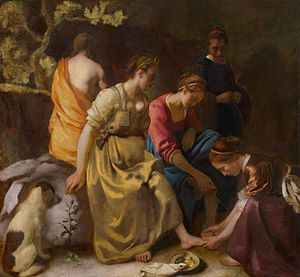Diana with her companions

|
| Diana with her companions |
|---|
| Jan Vermeer , 1655/1656 |
| Oil on canvas |
| 98.5 x 105 cm |
| Mauritshuis |
Diana with her companions is a history painting painted 1655/1656 andattributed to Jan Vermeer . The 98.5 centimeter high and 105 centimeter wide oil painting depicts Diana, the goddess of the hunt. It is the third painting by Vermeer in the genre of history painting after Christ with Maria and Martha and The Holy Praxedis that he made at the beginning of his career as a painter. Today itcan be seenin the Mauritshuis .
Since the picture was said to have deficiencies, especially in the representation of the postures, doubts were repeatedly voiced that it was a work of Vermeer's at all. To this day, these doubts can neither be confirmed nor refuted.
Image description
The painting Diana with her companions shows Diana, also called Artemis , in the company of four nymphs . The identity of the Greek goddess of the hunt sitting on a stone in the center of the picture, who was considered particularly chaste , is made clear by the diadem , which shows the crescent moon as her attribute. She wears an ocher-colored robe and lets a nymph kneel in front of her wash her bare feet. In the depiction of this ritual act, Vermeer takes up the Christian motif of the washing of feet. The picture is poor in action, two nymphs sit on the stone with Diana, one of them half-naked and turned away from the viewer, one stands in the background and looks at how the fourth does the washing of the feet. A dog is sitting on the left edge of the picture. The black-clad nymph in the background could be Callisto . The hands clasped on her stomach indicate her pregnancy , which she tries to hide.
The scene depicted by Vermeer takes place at dusk, which is why the faces of the women are in shadow. The darkness and the diadem with the crescent moon are an allusion to the frequent identification of Diana with the moon goddess Selene . The time also determines the color. So the background is very dark. In addition, the two nymphs positioned closest to the right edge of the picture are dressed in dark clothes. In contrast, Diana and the other two nymphs wear light-colored clothing that contrasts with the background.
restoration
The painting Diana with her companions was restored in 1999 . It turned out that the sky did not come from Vermeer, but was painted over the original later. This was linked to the use of Prussian blue , which was not discovered until after 1700, and chrome green , which was not discovered until around 1830. Analyzes showed that the color under the sky corresponded to the dark parts of the tree in the left background. Nevertheless, the sky was not removed again, as the layers of paint underneath could have been damaged and it was not possible to determine the condition of the original layer, but only painted over with a thin layer of dark brown paint. It was also found that a twelve centimeter wide strip of the image had been removed from the right edge of the image.
Provenance and attribution
On May 4, 1876, Victor de Stuers , an official responsible for art at the Dutch Foreign Ministry, bought the painting Diana with her companions for the Mauritshuis at an auction in Paris for 10,000 francs . At the time, the picture was still attributed to Nicolaes Maes , who was a student of Rembrandt van Rijn . In 1885 it was discovered that the signature NM was painted over J VMeer , so de Stuers now attributed the picture to Vermeer. However, this attribution was not confirmed, as there was hardly any information about the recently rediscovered Vermeer. Four years later, the new director of the Mauritshuis, Abraham Bredius , attributed the painting to Johann van der Meer because it was too different from the well-known works by Vermeer.
In 1901 the attribution changed again when the London art dealers Forbes & Robertson exhibited Jan Vermeer 's early work Christ with Mary and Martha . Bredius traveled to London with the deputy director, Willem Martin . Martin also attributed Diana and her companions to Jan Vermeer because of the similar colors and painting style , while Bredius was not convinced. In addition, similarities with the painting At the Coupler , another early work of Vermeer's, were cited.
Nevertheless, the question of ascription has not yet been clarified beyond doubt.
Individual evidence
- ^ Norbert Schneider: Vermeer all paintings . Taschen, Cologne 2004. page 23
- ↑ a b Epco Runia, Peter van der Ploeg: Vermeer in the Mauritshuis. Waanders Publishers, Zwolle 2005. Page 41
- ↑ Epco Runia, Peter van der Ploeg: Vermeer in the Mauritshuis. Waanders Publishers, Zwolle 2005. Page 40
- ↑ Epco Runia, Peter van der Ploeg: Vermeer in the Mauritshuis. Waanders Publishers, Zwolle 2005. page 39
literature
- Norbert Schneider: Vermeer all paintings . Taschen, Cologne 2004. ISBN 3-8228-6377-7
- Arthur K. Wheelock: Vermeer . 2nd Edition. DuMont Literature and Art Publishing, Cologne 2003, ISBN 3-8321-7339-0 , ( DuMont's library of great painters ).
- Epco Runia, Peter van der Ploeg: Vermeer in the Mauritshuis . Waanders Publishers, Zwolle 2005. ISBN 90-400-9073-4